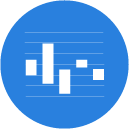 Page top
Page top
 Previous
Previous
 Homepage
Homepage
 Next
Next
Error Bars
Description
Although not a chart outright, Error Bars function as a graphical enhancement that visualises the variability of the plotted data on a Cartesian graph. Error Bars can be applied to graphs such as Scatterplots, Dot Plots, Bar Charts or Line Graphs, to provide an additional layer of detail on the presented data.
Error Bars help to indicate estimated error or uncertainty to give a general sense of how precise a measurement is. This is done through the use of markers drawn over the original graph and its data points. Typically, Error bars are used to display either the standard deviation, standard error, confidence intervals or the minimum and maximum values in a ranged dataset.
To visualise this information, Error Bars work by drawing cap-tipped lines that extend from the centre of the plotted data point (or edge with Bar Charts). The length of an Error Bar helps reveal the uncertainty of a data point: a short Error Bar shows that values are concentrated, signalling that the plotted average value is more likely, while a long Error Bar would indicate that the values are more spread out and less reliable. Also depending on the type of data, the length of each pair of Error Bars tend to be of equal length on both sides. However, if the data is skewed, then the lengths on each side would be unbalanced.
Error Bars always run parallel to a quantitative scale axis, so they can be displayed either vertically or horizontally, depending on whether the quantitative scale is on the Y or X axis. If there are two quantitative scales, then two pairs of Error Bars can be used for both axes.
Functions
Anatomy
Error Bars can be applied to:
Tools to Generate Visualisation
Code-based:
amCharts (JS)
AnyChart (JS)
FusionCharts (JS)
Google Charts (HTML5)
Highcharts (JS)
JSCharting (JS)
Vega
Vega-Lite
ZingChart (JS)
Webapp:
Google Docs
Plotly
Desktop App:
Apple Numbers
Microsoft Office
Tableau








